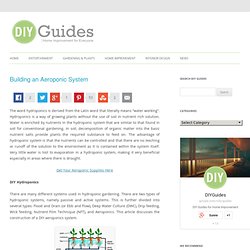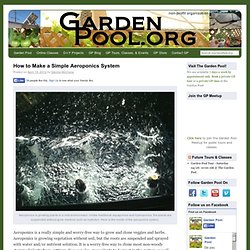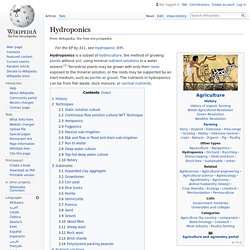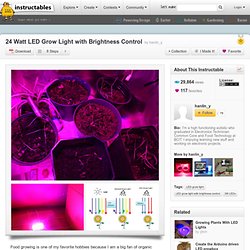

Review of estimation of plant rhizodeposition and their contribution to soil organic matter formation - Archives of Agronomy and Soil Science - Volume 50. The methods used for estimating rhizodeposition of plants (carbon (C) deposition of living roots), and the results obtained for different plant species are reviewed.

Three tracer techniques using C isotopes to quantify rhizodeposition are discussed: pulse labelling, continuous labelling, and natural 13C abundance. Only the tracer methods provided adequate results for the whole rhizodeposition. The differences in the below-ground C translocation pattern between cereals and grasses are discussed. Green electricity production with living plants and bacteria in a fuel cell. How to Build an Aeroponic System » DIY Guides. The word hydroponics is derived from the Latin word that literally means “water working”.

Hydroponics is a way of growing plants without the use of soil in nutrient rich solution. Water is enriched by nutrients in the hydroponic system that are similar to that found in soil for conventional gardening. In soil, decomposition of organic matter into the basic nutrient salts provide plants the required substance to feed on. The advantage of hydroponic system is that the nutrients can be controlled and that there are no leeching or runoff of the solution to the environment as it is contained within the system itself. Very little water is lost to evaporation in a hydroponic system, making it very beneficial especially in areas where there is drought.
How to Make a Simple Aeroponics System. Aeroponics is growing plants in a mist environment.

Unlike traditional aquaponics and hydroponics, the plants are suspended without grow medium such as hydroton. Here is the inside of the aeroponics system. Aeroponics is a really simple and worry-free way to grow and clone veggies and herbs. Aeroponics is growing vegetation without soil, but the roots are suspended and sprayed with water and/or nutrient solution. EASY HYDROPONICS EBB AND FLOW - TIPS. EASY HYDROPONICS EBB AND FLOW Part 7: Operating Tips & Techniques STOP!

If you have just arrived at this website looking for an easy hydroponics ebb and flow system, you might want to go back to page one of this mini-farm plan. NOW, let's learn how to take care of this baby! Well, you did it! Ebb and flow fittings. Hydroponics. NASA researcher checking hydroponic onions with Bibb lettuce to his left and radishes to the right Hydroponics is a subset of hydroculture, the method of growing plants without soil, using mineral nutrient solutions in a water solvent.[1] Terrestrial plants may be grown with only their roots exposed to the mineral solution, or the roots may be supported by an inert medium, such as perlite or gravel.

The nutrients in hydroponics can be from fish waste, duck manure, or normal nutrients. History[edit] In 1929, William Frederick Gericke of the University of California at Berkeley began publicly promoting that solution culture be used for agricultural crop production.[3][4] He first termed it aquaculture but later found that aquaculture was already applied to culture of aquatic organisms. Water Pump for an Aeroponic System.
By Greg (VA)

EcoPlus Submersible Water Pumps. Read Answers for EcoPlus Submersible Water Pumps Do you know how many watts these particular pumps will draw? -CJ We just added all the wattages to the product page for the EcoPlus water pumps. Operating your MFC. Now if you attach an external circuit through a resistor you should begin getting voltage out of your MFC.

The voltage will increase the bacterial population grows and then begin to decrease. If you don't get voltage there could be any number of good reasons, including the culture. Try again, make sure you get a good seal on the anode. Inbox (766) - antonio - Innovent Mail. 24 Watt LED Grow Light with Brightness Control. Greenhouse Aluminum foil Large box Plastic board Grow lamp 2 x 3W royal blue LED (445nm) 6 x 3W deep red LED (660 nm) Heatsink with fan Thermal paste Epoxy Solder (lead free when growing edibles) Note: You can get LEDs at e-Bay for as little as $2 each when you purchase them whole sale.

LED Driver 1A fuse with clips Resistors (0.33, 0.56, 1, and 100k ohm) N-channel MOSFET (eg. How to make a LED growbox. You need to do some homework on your reflectivity.

Foylon: A more durable version of mylar, made of spun polyester fabric and reinforced with foil laminate. Foylon is resistant to most solutions, won't tear or fade, and can be wiped or washed clean. A great solution for growers who are interested in long term use, and though it may be slightly more expensive than mylar, its durability will more than make up for its cost. It has the ability to reflect about 95% of the light and approximately 85% of the heat energy, so a good ventilation system should be used in conjunction with folyon. A recommended method to attach Foylon to the walls would be using Velcro, as it makes taking it down for cleaning much easier nd reduces the risk of tearing, creasing or bending it. Mylar: A highly reflective polyester film that comes in varying thickness, the most common being 1 and 2 mm thick.
How to Build a Plant Microbial Fuel Cell. Most microbial fuel cells are made using marine or pond bacteria, but it is still possible to produce a fuel cell which operates using a plant fuel, rather than a bacteria.

Although most plants cannot be used for this type of fuel production, as they lack the enzymes which can control electrons and power electricity, it is still possible to manage to make a fuel cell out of plant life. Step 1 - Create Your Anode and Cathode Open up the ends of the compression fitting, and ensure that the ends are roughened enough to fit neatly over the tubes of the fitting. Then, make a mark on one side of your plastic containers, and then measure across to the other container. Home. Bruce Logan Research - Microbial Fuel Cells. Overview Check out the MFC-cam, our on-line demonstration of an MFC! Renewable and clean forms of energy are one of society's greatest needs. At the same time, 2 billion people in the world lack adequate sanitation and the economic means to afford it. In this research, we are working to address both of these human needs.
Energy costs are an important factor in wastewater treatment. Microbial fuel cells (MFCs) represent a completely new method of renewable energy recovery: the direct conversion of organic matter to electricity using bacteria. Microbial Fuel Cells: Generating Power from Waste. Microbial Fuel Cells (MFCs) use bacteria to convert organic waste material into electrical energy. This environmentally-friendly process produces electricity without the combustion of fossil fuels. How Plant-microbial Fuel Cells Work" Soil, as it turns out, is full of untapped (electrical) potential. As green plants go about the business of photosynthesis -- converting energy from sunlight to chemical energy, then storing it in sugars like glucose -- they exude waste products through their roots into a soil layer known as the rhizosphere.
There, bacteria chow down on plants' sloughed-off cells, along with proteins and sugars released by their roots [source: Ingham]. In PMFC terms, this means that, as long as the plant lives, the bacteria have a meal ticket and the fuel cell generates power. The first law of thermodynamics, which some translate as "there's no such thing as a free lunch," still applies because the system receives energy from an external source, namely the sun. But how on Earth, or under it, do microbes generate electricity simply by consuming and metabolizing food? Bringing down the cost of microbial fuel cells. Engineers at the University of Wisconsin-Milwaukee (UWM) have identified a catalyst that provides the same level of efficiency in microbial fuel cells (MFCs) as the currently used platinum catalyst, but at 5% of the cost. Since more than 60% of the investment in making microbial fuel cells is the cost of platinum, the discovery may lead to much more affordable energy conversion and storage devices.
The material -- nitrogen-enriched iron-carbon nanorods -- also has the potential to replace the platinum catalyst used in hydrogen-producing microbial electrolysis cells (MECs), which use organic matter to generate a possible alternative to fossil fuels. "Fuel cells are capable of directly converting fuel into electricity," says UWM Professor Junhong Chen, who created the nanorods and is testing them with Assistant Professor Zhen (Jason) He. "With fuel cells, electrical power from renewable energy sources can be delivered where and when required, cleanly, efficiently and sustainably.
" Superior fuel cell material developed. Using a mixture of gold, copper and platinum nanoparticles, IBN researchers have developed a more powerful and longer lasting fuel cell material. This breakthrough was published recently in the journal, Energy and Environmental Science. Fuel cells are a promising technology for use as a source of electricity to power electronic devices, vehicles, military aircraft and equipment. A fuel cell converts the chemical energy from hydrogen (fuel) into electricity through a chemical reaction with oxygen. Electricity from the marshes.
An unexpected source of new, clean energy has been found: the Plant-Microbial Fuel Cell that can generate electricity from the natural interaction between living plant roots and soil bacteria. The technique already works on a small scale and will soon be applied in larger marshland areas throughout the world. Unique Carbon-Coated Cathodes Improve Electrical Conductivity (ANL-IN-09-043) - Energy Innovation Portal. Composite Cathode Material for Li-Ion Batteries Based on LiFePO4 System.
Reflected Near-Infrared Waves - Mission:Science. A portion of radiation that is just beyond the visible spectrum is referred to as near-infrared. Inda-GRO. Understanding PAR.